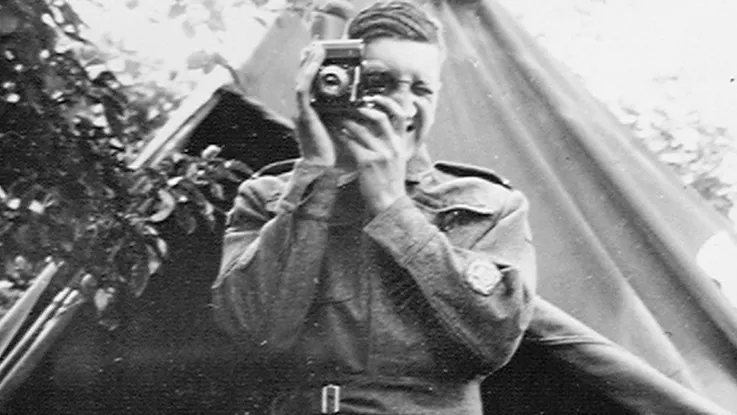A new front
Just as the British Army was beginning to rally and rebuild after the early losses suffered in France, a new threat emerged. On 10 June 1940, Italy's Fascist dictator, Benito Mussolini, declared war on Britain.
On 13 September, the Italians invaded Egypt from their territory in Libya. The following month, 2nd Armoured Division, with the exception of 22nd Armoured Brigade, was ordered to the Middle East. The 3rd County of London Yeomanry (Sharpshooters), along with the rest of 22nd Armoured Brigade, subsequently joined 1st Armoured Division.
Having spent much of 1940 on invasion alert, the Sharpshooters moved to Dorking in Surrey and embarked on further squadron training. In November, they received their first Cruiser tanks, listed in their war diary as Mark IVAs.
Cruisers
The designation of British Cruiser tanks is somewhat confusing. The A13 Mark I Cruiser tank went into production in 1940. It was armed with a 2-pounder gun and a Vickers machine gun, but was deemed to be under-armoured.
As a result, the A13 Mark II was developed utilising additional angled armour plates on the turret. Additional changes were made to the production models, including more armour for the gun mantlet and a rounded commander’s cupola.
The A13 IIA included modifications that allowed a BESA machine gun to replace the Vickers. In June 1940, the A13 Mark I was re-designated the Cruiser Mark III and the A13 Mark II became the Cruiser Mark IV, with the modified BESA carrying Mark II model becoming the Cruiser Mark IVA.
The Cruiser variants did not fare well in France and proved susceptible to German anti-tank guns. But they were still used in large numbers in North Africa. The A13 Cruiser Mark IV last saw action in Operation Crusader in November 1941.
First loss
The Sharpshooters’ war diary records that on 14 November 1940, during a period of squadron training, Second Lieutenant Basil Stevens was killed in a motor accident. Sale photographed the officer’s funeral at St Mary’s Church in Chiddingfold.
With hindsight, these photographs are particularly poignant given the numbers of casualties Sale documented later in the war.
More training
Over the winter of 1940-41, the Sharpshooters were involved in major training exercises. In February 1941, their gunnery skills were honed at the Castlemartin Training Area in South Wales.
The Sharpshooters received more Cruiser tanks while in Wales. But live firing was restricted to eight live rounds per 2-pounder gunner, a reflection of the dire shortage of weapons and munitions. Indeed, in the spring of 1941, the unit's first issue of new tanks were withdrawn and sent to the Middle East to reinforce the hard-pressed forces fighting in North Africa.
During this period, the 3rd County's soldiers were billeted at Stackpole Court. They clearly enjoyed the stunning Pembrokeshire countryside near Linney Head.
North Africa
On 11 February 1941, Major-General Erwin Rommel's German Afrika Korps landed at Tripoli in Libya to bolster the Italians' flagging campaign in North Africa.
Rommel helped reverse recent Allied gains and drove British and Commonwealth forces back to the Egyptian border. This left the garrison of the strategically important port of Tobruk under siege.
Surrey
Meanwhile, the 3rd County of London Yeomanry returned to southern England to train on the South Downs between Worthing and Arundel. Sale and his comrades were billeted in comfortable country houses requisitioned in Cherfold and Chiddingfold.
As with billets wherever the Sharpshooters went, the accommodation was customised to meet their needs and wants, and included makeshift bars for officers and men.
To Salisbury Plain
In May 1941, the Sharpshooters were based at Dorking in Surrey, where intensive squadron training was undertaken. New equipment arrived in the form of Cruiser tanks of various marks as 22nd Armoured Brigade relocated to training areas on Salisbury Plain.
From the Home Counties, the Sharpshooters moved to Westbury in Wiltshire. The unit’s initial road and rail move occurred at the end of May 1941.
Unit strength
According to the unit’s war diary, on 1 June 1941, the Sharpshooters numbered 40 officers and 589 other ranks.
The unit was equipped with 16 Crusader tanks, six Covenanters, 26 Vickers Light Mark VI tanks, 10 scout cars and seven personnel carriers, along with around 65 soft-skin vehicles and 17 motorcycles.
Final preparations
Sale took a lot of photographs at Westbury, documenting the Sharpshooters’ final period of training before being deployed overseas. His images show the unit working on physical fitness, vehicle maintenance, weapons training and tactics.
Despite this, there was still time for some recreational activities and even a romance or two.
Mobilisation
On 31 July 1941, the 22nd Armoured Brigade was ordered to mobilise for service overseas.
In the last week of July, the 3rd's sister unit, the 4th County of London Yeomanry, then based at Warminster, was inspected by Winston Churchill and both the King and Queen. They then prepared to move to Liverpool for embarkation.
During the first two weeks of August, with leave cancelled, the men of the 3rd also prepared for departure. A final parade and inspection were held at Westbury on 14 August 1941.
Embarkation
The 3rd County of London Yeomanry, with 40 officers and around 600 other ranks, then moved from Westbury to Avonmouth. There, they embarked on HMT 'Orion', a converted passenger liner, sailing on the morning of 15 August 1941. The war diary reports that one soldier was ‘put ashore before sailing as insane’.
The Sharpshooters were at last going to war. But, for all their esprit de corps and training, nothing could have fully prepared them for the baptism of fire they were about to receive in North Africa.

























